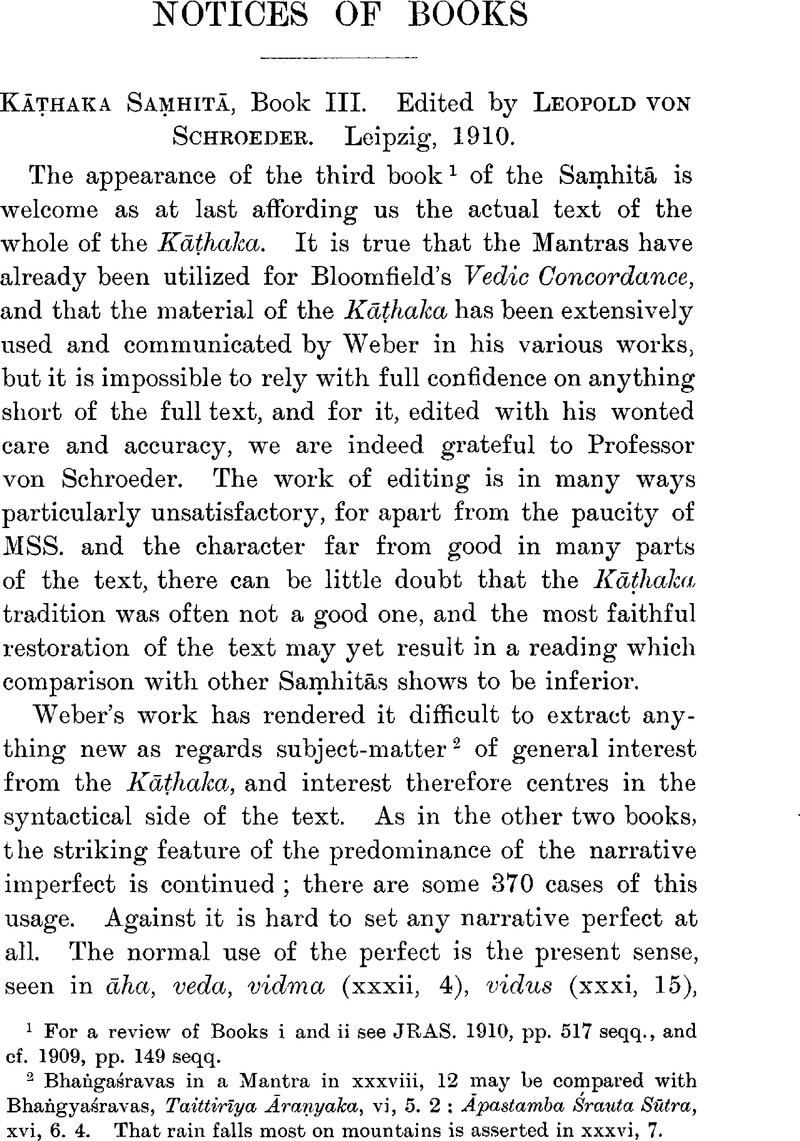No CrossRef data available.
Published online by Cambridge University Press: 15 March 2011

page 1095 note 1 For a review of Books i and ii see JRAS. 1910, pp. 517 seqq., and cf. 1909, pp. 149 seqq.
page 1095 note 2 Bhaṅgaśravas in a Mantra in xxxviii, 12 may be compared with Bhaṅgyaśravas, , Taittirlya Āraṇyaka, vi, 5. 2Google Scholar; Āpastamba Śrauta Sūtra, xvi, 6. 4. That rain falls most on mountains is asserted in xxxvi, 7.
page 1096 note 1 Cf. Kauṣsītaki Brāhmaṇa, vii, 6: yo vā tata āgachati tasya vā ṠuṠrūṣsanta iti ha smāha, if Muir, Sanskrit Texts, ii2, 328, is right in taking this as a quotation. If not, it illustrates xxxiv, 17, as abravit follows.
page 1096 note 2 See e.g. Aitareya Brādhmaṇhmaṇa, viii, 23; JRAS. 1909, p. 150; 1912, p. 724.
page 1097 note 1 This form is very frequent, and it occurs not rarely without a finite verb, but it never has the narrative sense as in later Sanskrit. It expresses the state as existing in the present when no verb is used, e.g. praviṣṭaḥ, xxxi, 15; see Keith, , ZDMG. lxiii, 348, 349Google Scholar.
page 1098 note 1 e.g. xxxii, 7; xxxvii, 11; cf. Keith, , Classical Quarterly, v, 128Google Scholar.
page 1099 note 1 The Kapiṣṭhala points to mārkṣyāmahā as the reading, as in Maitrāyāṇī Saṃhitā, iv, 1. 9 (see above, JRAS. 1910, p. 157).
page 1099 note 2 Cf. JRAS. 1910, p. 1320.
page 1099 note 3 Keith, , JRAS. 1909, p. 430Google Scholar.
page 1100 note 1 See Keith's ed., p. 242.
page 1100 note 2 See Speyer, , ZDMG. Ixiv, 316 seqqGoogle Scholar.
page 1100 note 3 Whitney, , Sanskrit Grammar, § 1191Google Scholar.
page 1101 note 1 Whitney, , Sanskrit Grammar, § 1193Google Scholar.
page 1101 note 2 See e.g. Taittirīya Saṃhitā, iii, 5. 4. 2, as against Maitrayanī Saṃmhitā, i, 4. 3.
page 1101 note 3 See St. Petersburg Dictionary, iii, 902.
page 1101 note 4 See Keith, , JRAS. 1910, p. 468Google Scholar; Oldenberg, , ZDMG. lxiii, 287, 288Google Scholar.
page 1101 note 5 Altind. Gramm. II, i, 163.
page 1102 note 1 Böhtlingk agrees; Eggeling renders “bullock” in Śatapatha Brāhmāṇa, iv, 5. 1. 9. Cf. possibly yogakṣema in Taittirīya, vii, 5. 18.
page 1102 note 2 But kūbara may equally well be merely a variant of kūbara (Maitrāyaṇī Saṃhitā, ii. 1. 11), “cart pole”; for v and b, see Wackernagel, I, 183.
page 1102 note 3 Wackernagel, II, i, 265. The form kulīraya found here for the pulīkaya of the Maitrāyaṇī, iii, 14. 2, 6, kulīpaya of the Vājasaneyi, xxiv, 25, and kulīkaya of the Taittirīya, v, 5, 13, is probably a mere case of a blunder; the original was pulīkaya or kulīpaya, and a corrector inserted rī (or vice versa), with the result that it has ousted the syllable ka or pa; a similar case of a correction being treated as part of the text is found in the Kapiṣṭhala Saṃhitā, xxviii, 8, where lalāya corresponds to laya (Taittirīya, iv, 7. 3) or Iāya (Kāṭhaka, xviii, 8), meaning perhaps “ploughshare”.
page 1102 note 4 Wackernagel, II, i, 47.
page 1102 note 5 Ibid. 193; not only is such a compound unknown to early texts, but the sense requires the participle to be passive.
page 1103 note 1 ZDMG. Ixv, 306, 307; cf. Charpentier, , ZDMG. lxvi, 45Google Scholar; Oldenberg, , NGGW. 1912, p. 184Google Scholar; the ekātithiṃ ruṇaddhi of the Aitareya confirms the second version of the Mahābhārata (ZDMG. lxiv, 74) and the Bhisajātaka.
page 1103 note 2 Ind. Stud, iii, 468.